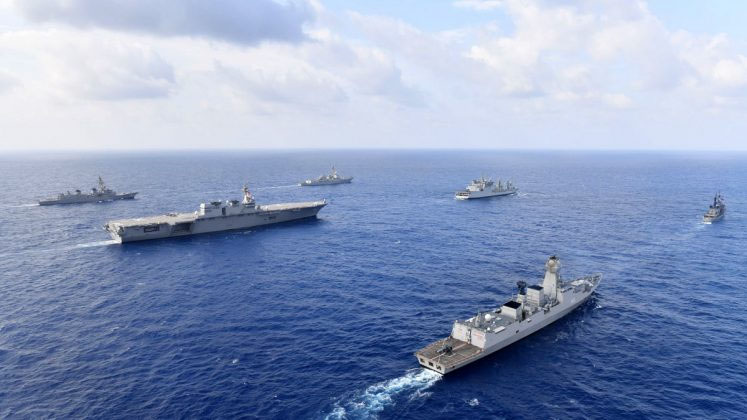South China Sea: US Clash With China Now ‘Inevitable’
19 July, 2020
A clash within the South China Sea is now almost inevitable. The US has declared China’s territorial grab “illegal”. It wants its “bullied” neighbours to stand their ground.
“We are making clear: Beijing’s claims to offshore resources across most of the South China Sea are completely unlawful, as is its campaign of bullying to control them,” a US statement issued earlier this week asserts.
It’s not a change of opinion. But it is a loud declaration of intent to establish a ‘line in the sand’ that Beijing should not cross.
“The United States is now explicitly declaring it illegal for China to engage in fishing, oil and gas exploration, or other economic activities in those areas, or to interfere with its neighbours’ rights to do so,” says Asia Maritime Initiative senior fellow Gregory Poling.
“The next time China does engage in illegal harassment of its neighbours within their EEZs (exclusive economic zones), a more forceful US response might lead China to double down out of a sense of nationalism,” he added.
China’s “wolf-warrior” rhetoric has given it little wiggle room to back down.
“Perhaps now Beijing feels like it’s pushed up against a wall,” Australian National University School of International Relations doctoral candidate Hunter Marston told news.com.au. “All these countries are now more or less affirming the 2016 Permanent Court of Arbitration decision. Perhaps they (Beijing) say what else do they have to lose? You know, the gloves are off.”
And that lays the groundwork for open confrontation.
It’s a fear echoed in a report by Council on Foreign Relations assistant professor Oriana Skylar Mastro: “China could see military action as its only recourse if it loses the diplomatic option to assert its sovereignty claims. The continued downward spiral in US-China relations could also encourage Xi to adopt a now-or-never approach to the South China Sea.”
Wounded wolves
Beijing is getting irritated. The Chinese Communist Party has called Washington a “spoiler, saboteur and disrupter”.
“Although Washington doesn’t want to start a real war with China, there is the possibility of the unfolding of miscalculations if it continues to try and stir up trouble in the South China Sea,” declares the editor of the Communist Party’s China Daily.

An aerial file photo shows a Chinese navy formation during military drills in the South China Sea on January 2, 2017.
Beijing’s diplomats are racing to re-establish dominance over the narrative.
“China’s position on the South China Sea issue has been consistent and clear-cut. While firmly safeguarding its territorial sovereignty and maritime rights and interests, China has been committed to resolving disputes through negotiation and consultation with countries directly involved, managing differences through rules and mechanisms, and achieving win-win results through mutually beneficial co-operation,” said a spokesperson for the Chinese embassy in the US.
The embassy declares the South China Sea has “remained peaceful and stable and is still improving”, ignoring a recent spate of rammings of fishing vessels, high-seas stand-offs over sea exploration efforts and its arbitrary construction of military bases on artificial islands.
“Under the pretext of endorsing rules, it is using UNCLOS to attack China while refusing to ratify the Convention itself. Under the pretext of upholding freedom of navigation and overflight, it is recklessly infringing on other countries’ territorial sea and airspace and throwing its weight around in every sea of the world,” the spokesperson added.
Beijing is a signatory to the UN’s law of the sea (UNCLOS) but has declared all rulings against its interests as being irrelevant or invalid.
Washington is not a signatory of UNCLOS but is seeking to enforce its jurisdiction over the dispute. But, Marston points out, the US has been conforming to law where Beijing has not.
“I think Washington’s really got international law at its back here, and so it’s hopefully welcomed as a legally defensible and robust statement in support of international law.”

The Independence-variant littoral combat ship USS Gabrielle Giffords (LCS 10) conducts routine operations in the South China Sea, June 30, 2020. Picture: U.S. navy photo
‘Bully’ Tactics
“Despite being a non-claimant of the South China Sea, the US desires to stir up troubles. It takes advantage of regional countries’ claims to sow discord between these countries and China. It portrays a bully image of China,” writes National Institute for South China Sea Studies director Yan Yan.
But Beijing has been actively cultivating a ‘strong man’ image in the region, rejecting any attempt to reach a real consensus. The Philippines and Vietnam have had several fishing vessels rammed by Chinese militia and coast guard vessels in recent months.
Vietnam and Malaysia have had ocean-bed exploration efforts disrupted even as Beijing sent its own surveying vessels into their waters. And Japan and Indonesia have been experiencing sustained incursions by Chinese militia and coast guard vessels within the East and remote South China Seas.
It is against this background that Japan joined Australia and the US in decrying China’s “dangerous and coercive” use of its ocean-going forces.
Australian Defence Minister Linda Reynolds, Japanese Minister of Defence Kono Taro and US Secretary of Defence Mark Esper have “expressed serious concern about recent incidents, including the continued militarisation of disputed features, dangerous or coercive use of coast guard vessels and ‘maritime militia,’ and efforts to disrupt other countries’ resource exploitation activities.”
Power Struggle
The United States has a keen interest in preventing China from asserting control over the South China Sea. “Maintaining free and open access to this waterway is not only important for economic reasons, but also to uphold the global norm of freedom of navigation,” says Mastro.
“China’s ability to control this waterway would be a significant step toward displacing the United States from the Indo-Pacific region, expanding its economic influence, and generally reordering the region in its favour.”
China’s Communist Party has again issued a veiled warning to its neighbours.
“It is to be hoped that countries in the region remain clear-eyed about the progress they have made in agreeing a code of conduct for the South China Sea and do not let Washington’s ‘official’ meddling undermine the consensus that peace and stability benefit all in the region,” states the Global Times.
The US, Marston says, is not dividing up territory. It remains neutral as to who has ownership over what established islands, arguing the United Nations has clearly defined procedures and standards under which such disputes can be resolved.
It’s by those standards and criteria Washington reaffirmed in its statement.
“Washington will no longer remain neutral over the low tide elevation shoals that are not recognised as granting Exclusive Economic Zones or territorial waters,” Marston says. “Nobody can claim them, but they can fall within the EEZ’s rights from adjacent coastlines, so we’re declaring Chinese fishing and oil and gas exploration in those waters illegal.”
A Line In The Sand
Beijing’s successful tactic until now has been ‘creeping’ expansionism. It makes a bold move (such as putting a weather station on a contested reef). It weathers the criticism. It makes the situation ‘the new normal’. Then it takes another bold move (such as turn that reef into a concrete island).

The disputed Spratly Islands in the South China Sea.
Washington’s declaration makes it harder to get away with such behaviour.
“This new rhetorical position won’t have much effect by itself. But as the opening gambit in a long-term effort to impose cost on China and rally support for US partners, it could be significant,” Poling writes. “It is much easier to rally international support against “illegal” activity than against actions that are merely distasteful or destabilising.”
“It is also much more damaging to a country that aspires to global leadership to be accused of gross violations of international law.”
But framing the dispute in terms of international law is an opportunity for both Beijing and Washington, Marston says. It gives China the opportunity to argue it is being conciliatory and reasonable if it choses to conform to its rule. It gives Washington the opportunity to present itself as the defender of weaker states if it does not.
However, Mastro argues Beijing’s response will likely be to not back down.
“China could adopt more aggressive rules of engagement against other countries’ air or sea operations in the area. This could include clipping a US naval vessel, locking radar onto a US aircraft, or conducting more frequent and provocative military exercises.” she writes.

Royal Australian Navy helicopter frigate HMAS Parramatta conducts officer of the watch manoeuvres with amphibious assault ship USS America.
The military-grade airfields on China’s illegal island fortresses could have combat jets stationed there to enforce an “air defence identification zone” over the Spratly Islands. It already has radars and missile defences in place.
Such a move would enable Beijing to declare – and enforce – the waters as territorial
“This would significantly affect trade lanes, fisheries and fishing rights, and freedom of navigation through these areas,” she says.
“While less likely, China could take military action against other claimants, or even US vessels. China could occupy or militarise the Scarborough Shoal — contested territory between China and the Philippines — that the United States has clearly communicated as a red-line that could lead to escalation.”
What Next?
The likelihood of some form of a standoff in the South China Sea has increased.
“This seems especially likely amid the current pandemic, which has led Chinese diplomats to favour chest-thumping nationalism over de-escalation with its neighbours,” Poling argues.
Ultimately, however, he says, greater resistance could drive compromise.
“In the long term, if successfully couched within a broader policy combining pressure on Beijing and greater international coalition building to support Southeast Asian parties, it could help steer China toward a compromise that the international community could live with.”
But Beijing has a well-established tendency to respond to pressure with escalation.
“One of China’s main strategies in promoting its claims in the past has been to increase the risks for others exercising their rights by, for example, harassing other countries’ oil and gas exploration platforms, fishing vessels, and military vessels,” Mastro writes.
And Washington’s declaration is likely to cause Beijing to double down.
“Xi could feel compelled to accelerate his timeline in the South China Sea to maintain his consolidated position within the Chinese Communist Party (CCP)”.
Then there’s Beijing’s new-found confidence in its vastly expanded, modernised military.
“With expectations that the first stage of China’s military modernisation efforts will be completed in 2020, Xi could become more confident that China would succeed in pressing its claims militarily, especially if the United States is distracted internally.”
Exactly what form any response will take is yet to pan out.
“Perhaps Beijing will think it is time to declare that air defence identification zone that has been rumoured about in the South China Sea for years,” says Marston. “But it has already done this in the East China Sea. It hasn’t really enforced it. It’s been more symbolic and a bit of an intimidation tactic. But it also sort of exposes the paper tiger nature of some of these acts.”
The views expressed in this article are the writer’s, they do not reflect the views of Opera News.
Source: news.com.au
Courtesy: Opera News/ news.com.au

